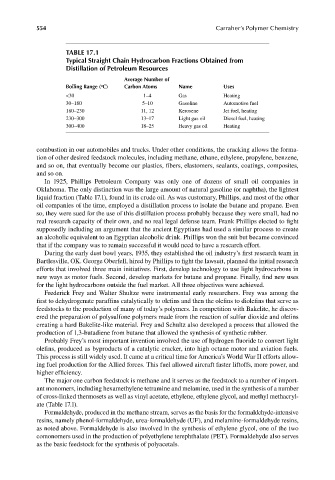Page 591 - Carrahers_Polymer_Chemistry,_Eighth_Edition
P. 591
554 Carraher’s Polymer Chemistry
TABLE 17.1
Typical Straight Chain Hydrocarbon Fractions Obtained from
Distillation of Petroleum Resources
Average Number of
Boiling Range ( C) Carbon Atoms Name Uses
o
<30 1–4 Gas Heating
30–180 5–10 Gasoline Automotive fuel
180–230 11, 12 Kerosene Jet fuel, heating
230–300 13–17 Light gas oil Diesel fuel, heating
300–400 18–25 Heavy gas oil Heating
combustion in our automobiles and trucks. Under other conditions, the cracking allows the forma-
tion of other desired feedstock molecules, including methane, ethane, ethylene, propylene, benzene,
and so on, that eventually become our plastics, fibers, elastomers, sealants, coatings, composites,
and so on.
In 1925, Phillips Petroleum Company was only one of dozens of small oil companies in
Oklahoma. The only distinction was the large amount of natural gasoline (or naphtha), the lightest
liquid fraction (Table 17.1), found in its crude oil. As was customary, Phillips, and most of the other
oil companies of the time, employed a distillation process to isolate the butane and propane. Even
so, they were sued for the use of this distillation process probably because they were small, had no
real research capacity of their own, and no real legal defense team. Frank Phillips elected to fi ght
supposedly including an argument that the ancient Egyptians had used a similar process to create
an alcoholic equivalent to an Egyptian alcoholic drink. Phillips won the suit but became convinced
that if the company was to remain successful it would need to have a research effort.
During the early dust bowl years, 1935, they established the oil industry’s first research team in
Bartlesville, OK. George Oberfell, hired by Phillips to fight the lawsuit, planned the initial research
efforts that involved three main initiatives. First, develop technology to use light hydrocarbons in
new ways as motor fuels. Second, develop markets for butane and propane. Finally, fi nd new uses
for the light hydrocarbons outside the fuel market. All three objectives were achieved.
Frederick Frey and Walter Shultze were instrumental early researchers. Frey was among the
first to dehydrogenate paraffins catalytically to olefins and then the olefins to diolefins that serve as
feedstocks to the production of many of today’s polymers. In competition with Bakelite, he discov-
ered the preparation of polysulfone polymers made from the reaction of sulfur dioxide and olefi ns
creating a hard Bakelite-like material. Frey and Schultz also developed a process that allowed the
production of 1,3-butadiene from butane that allowed the synthesis of synthetic rubber.
Probably Frey’s most important invention involved the use of hydrogen fl uoride to convert light
olefins, produced as byproducts of a catalytic cracker, into high octane motor and aviation fuels.
This process is still widely used. It came at a critical time for America’s World War II efforts allow-
ing fuel production for the Allied forces. This fuel allowed aircraft faster liftoffs, more power, and
higher effi ciency.
The major one carbon feedstock is methane and it serves as the feedstock to a number of import-
ant monomers, including hexamethylene tetramine and melamine, used in the synthesis of a number
of cross-linked thermosets as well as vinyl acetate, ethylene, ethylene glycol, and methyl methacryl-
ate (Table 17.1).
Formaldehyde, produced in the methane stream, serves as the basis for the formaldehyde-intensive
resins, namely phenol-formaldehyde, urea-formaldehyde (UF), and melamine-formaldehyde resins,
as noted above. Formaldehyde is also involved in the synthesis of ethylene glycol, one of the two
comonomers used in the production of polyethylene terephthalate (PET). Formaldehyde also serves
as the basic feedstock for the synthesis of polyacetals.
9/14/2010 3:43:17 PM
K10478.indb 554 9/14/2010 3:43:17 PM
K10478.indb 554

